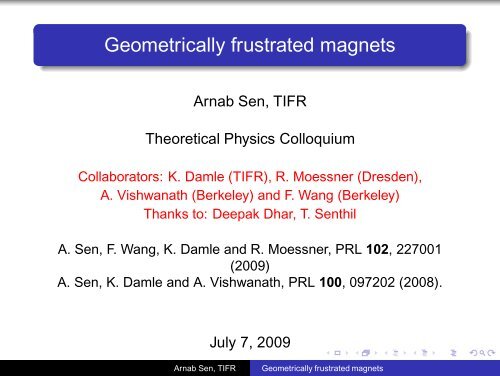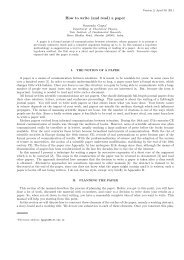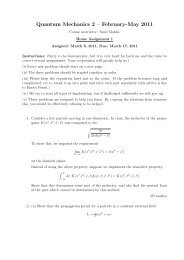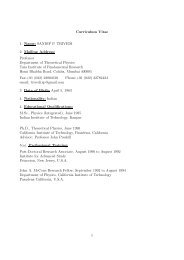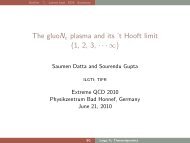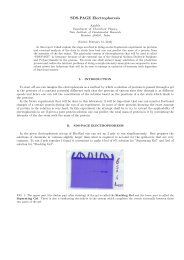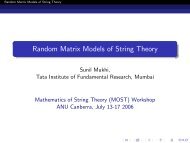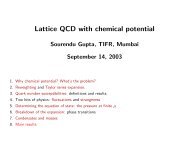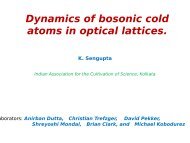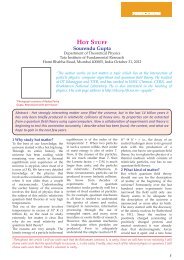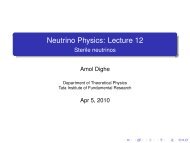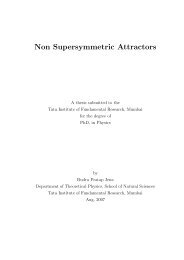Geometrically frustrated magnets - Department of Theoretical Physics
Geometrically frustrated magnets - Department of Theoretical Physics
Geometrically frustrated magnets - Department of Theoretical Physics
Create successful ePaper yourself
Turn your PDF publications into a flip-book with our unique Google optimized e-Paper software.
<strong>Geometrically</strong> <strong>frustrated</strong> <strong>magnets</strong><br />
Arnab Sen, TIFR<br />
<strong>Theoretical</strong> <strong>Physics</strong> Colloquium<br />
Collaborators: K. Damle (TIFR), R. Moessner (Dresden),<br />
A. Vishwanath (Berkeley) and F. Wang (Berkeley)<br />
Thanks to: Deepak Dhar, T. Senthil<br />
A. Sen, F. Wang, K. Damle and R. Moessner, PRL 102, 227001<br />
(2009)<br />
A. Sen, K. Damle and A. Vishwanath, PRL 100, 097202 (2008).<br />
July 7, 2009<br />
Arnab Sen, TIFR<br />
<strong>Geometrically</strong> <strong>frustrated</strong> <strong>magnets</strong>
Magnetism in ionic insulators<br />
Many ionic insulators have magnetic ions with an<br />
associated magnetic moment due to incomplete shells.<br />
Interactions between these localized moments.<br />
Magnetic dipolar interaction energy (small ∼ 10 −5 eV).<br />
Exchange energy E = J ∑ 〈ij〉 S i · S j due to Coulomb<br />
interactions and Pauli exclusion.<br />
How big is J? When is it positive?<br />
Difficult questions.<br />
Arnab Sen, TIFR<br />
<strong>Geometrically</strong> <strong>frustrated</strong> <strong>magnets</strong>
Superexchange interaction<br />
Consider MnO which is<br />
antiferromagnetic ionic solid.<br />
Mn 2+ has 5 electrons in its d shell<br />
being parallel due to Hund’s rule.<br />
O 2− has fully occupied p orbitals.<br />
Antiparallel alignment <strong>of</strong> spins in<br />
neighbouring Mn ions has lower<br />
kinetic energy due to delocalization<br />
<strong>of</strong> electrons (virtual hoppings).<br />
Arnab Sen, TIFR<br />
<strong>Geometrically</strong> <strong>frustrated</strong> <strong>magnets</strong>
Un<strong>frustrated</strong> <strong>magnets</strong><br />
Usually ordered states at low temperature T (O(JS 2 )).<br />
Ordering at low T largely determined by classical<br />
energetics even for small spin length S for un<strong>frustrated</strong><br />
<strong>magnets</strong>.<br />
E.g. ground state for cubic lattice Heisenberg<br />
antiferromagnet is the Neel state and the low energy<br />
excitations are long wavelength spin waves.<br />
Arnab Sen, TIFR<br />
<strong>Geometrically</strong> <strong>frustrated</strong> <strong>magnets</strong>
Frustration<br />
Not all the interactions can be simultaneously satisfied.<br />
Randomness: e.g., Spin glasses<br />
Multiple interactions: e.g., J 1 − J 2 Model<br />
Geometry<br />
J<br />
J<br />
_ J<br />
J 1<br />
J 2<br />
?<br />
J<br />
2 J 1<br />
> J 2<br />
J 2<br />
> 2 J 1<br />
Arnab Sen, TIFR<br />
<strong>Geometrically</strong> <strong>frustrated</strong> <strong>magnets</strong>
Geometric frustration<br />
Arrangement <strong>of</strong> spins on the lattice such that all<br />
interactions cannot be satisfied together.<br />
Neel state avoided. Simplest case:<br />
In extreme cases, macroscopic degeneracy <strong>of</strong> classical<br />
minimum energy configurations (highly <strong>frustrated</strong><br />
<strong>magnets</strong>).<br />
?<br />
Arnab Sen, TIFR<br />
<strong>Geometrically</strong> <strong>frustrated</strong> <strong>magnets</strong>
Schematic <strong>of</strong> magnetic susceptibility<br />
No magnetic ordering even for T well below O(JS 2 ) unlike<br />
un<strong>frustrated</strong> <strong>magnets</strong>, instead in a cooperative<br />
paramagnetic regime (J. Villain (1979)).<br />
T → 0: Quantum effects+ subdominant interactions like<br />
next nearest neighbour interactions, magnetic anisotropies<br />
etc.<br />
θ cw<br />
= −500K<br />
non−generic<br />
cooperative<br />
paramagnet<br />
paramagnet<br />
x=7/9<br />
f= |θcw| /T*<br />
x=1/9<br />
θ cw<br />
χ −1 T *<br />
−θ cw<br />
T<br />
SCGO ( Sr Cr 9−9xGa 3+9x O 19 )<br />
Fig from Martinez et al., PRB 46, 10786 (1992)<br />
Arnab Sen, TIFR<br />
<strong>Geometrically</strong> <strong>frustrated</strong> <strong>magnets</strong>
Materials<br />
Pyrochlore<br />
Kagome<br />
Triangular<br />
Hagemann et al., PRL 86, 894 (2001).<br />
Arnab Sen, TIFR<br />
<strong>Geometrically</strong> <strong>frustrated</strong> <strong>magnets</strong>
Interesting questions<br />
Spin liquids<br />
Description <strong>of</strong> the system when there is no magnetic<br />
ordering? Is the physics trivial?<br />
Signatures/probes <strong>of</strong> such correlated phases?<br />
Sensitivity<br />
How can degeneracy be split?<br />
Can unusual states be obtained in this way?<br />
’Quenching’ <strong>of</strong> leading exchange interactions allow new physics<br />
to happen.<br />
Arnab Sen, TIFR<br />
<strong>Geometrically</strong> <strong>frustrated</strong> <strong>magnets</strong>
Macroscopic degeneracy I<br />
Macroscopic degeneracy <strong>of</strong> ground states <strong>of</strong> the Ising<br />
antiferromagnet on both kagome and triangular lattice.<br />
Disordered at all temperatures.<br />
Kagome<br />
a<br />
Triangular<br />
c<br />
b<br />
a<br />
c<br />
b<br />
a<br />
c<br />
b<br />
a<br />
c<br />
b<br />
a<br />
c<br />
b<br />
a<br />
Arnab Sen, TIFR<br />
<strong>Geometrically</strong> <strong>frustrated</strong> <strong>magnets</strong>
Macroscopic degeneracy II<br />
Zero modes for the kagome lattice Heisenberg<br />
antiferromagnet.<br />
Triangular lattice Heisenberg antiferromagnet forms an<br />
ordered state at low temperatures.<br />
Arnab Sen, TIFR<br />
<strong>Geometrically</strong> <strong>frustrated</strong> <strong>magnets</strong>
Ground state correlations<br />
Local constraints can lead to long-ranged correlations.<br />
Best example → dipolar spin liquid on the pyrochlore<br />
lattice.<br />
∑<br />
☒ Sα i<br />
= 0 → ∇ · ⃗B α = 0.<br />
Power-law correlators–〈B l i (0)Bm j<br />
(r)〉 ∝ δ lm<br />
( 3ri r j −r 2 δ ij<br />
r 5 ).<br />
e 2<br />
x<br />
e 4<br />
z<br />
y<br />
e 1<br />
e 3<br />
Isakov, Gregor, Moessner and Sondhi, PRL 93, 167204 (2004).<br />
Arnab Sen, TIFR<br />
<strong>Geometrically</strong> <strong>frustrated</strong> <strong>magnets</strong>
Quantum fluctuations<br />
Quantum fluctuations can be introduced in a perturbative<br />
manner by doing a 1/S expansion.<br />
Large-S calculations on kagome lattice lead to an ordered<br />
state (Chubukov, PRL 69, 832 (1992)).<br />
Arnab Sen, TIFR<br />
<strong>Geometrically</strong> <strong>frustrated</strong> <strong>magnets</strong>
S = 1/2 Case<br />
Precise nature <strong>of</strong> ground state<br />
remains a subject <strong>of</strong> debate.<br />
Exact diagonalization studies find<br />
very short ranged spin-spin<br />
correlations and a spin gap <strong>of</strong><br />
△ ≈ 0.25J.<br />
Recent study finds a state with a 36<br />
site unit cell to be the ground state<br />
(Singh and Huse, PRB 76,<br />
180407(R) (2007)).<br />
Also obtained by Nikolic and Senthil (PRB, 68, 214415<br />
(2003), Fig from there) using a Resonating-Valence-Bond<br />
picture (Anderson, Science 235, 1196 (1987)) .<br />
Arnab Sen, TIFR<br />
<strong>Geometrically</strong> <strong>frustrated</strong> <strong>magnets</strong>
Single-ion anisotropy<br />
Motion <strong>of</strong> the electrons in the magnetic ions influenced by<br />
the crystalline environment.<br />
Energy depends on the absolute orientation with respect to<br />
the crystal axes.<br />
H = J ∑ 〈ij〉 ⃗ S i · ⃗S j − D ∑ i (⃗ S i · ˆn i ) 2<br />
Pyrochlore spin ice Ho 2 Ti 2 O 7 (Ho 3+ , J=8)<br />
Easy axes ˆn point outward from center <strong>of</strong> each<br />
tetrahedron, D ∼ 50K, J ∼ 1K .<br />
Harris et. al., PRL 79, 2554 (1997).<br />
Kagome Nd-langasite Nd 3 Ga 5 SiO 14 (Nd 3+ , J=9/2)<br />
Easy axis perpendicular to lattice plane,<br />
D ∼ 10K, J ∼ 1.5K<br />
A. Zorko et. al., PRL 100, 147201 (2008).<br />
Arnab Sen, TIFR<br />
<strong>Geometrically</strong> <strong>frustrated</strong> <strong>magnets</strong>
Our work<br />
S ≥ 3/2 easy axis on the kagome and triangular lattices:<br />
H = J ∑ 〈ij〉 S i · S j − D ∑ i (Sz i<br />
) 2<br />
<strong>Physics</strong> when D term forces a collinear state?<br />
Best answered by working out small J/D expansion for<br />
effective Hamiltonian for pseudospin-1/2 variables σ i<br />
(σ z = ±1 ↔ S z = ±S).<br />
Assumption: Perturbative results in J/D will be valid as long as<br />
collinear states selected by anisotropy.<br />
Arnab Sen, TIFR<br />
<strong>Geometrically</strong> <strong>frustrated</strong> <strong>magnets</strong>
Zero field<br />
To O(J 3 /D 2 ), H eff is given as<br />
∑<br />
H eff = J 1 〈ij〉 σ 1−σ<br />
iσ j − J i σ j<br />
2<br />
∑〈ij〉 2<br />
(σ i H i + σ j H j )<br />
where<br />
J 1 = JS 2 , J 2 = (S 3 J 3 )/(4D 2 (2S − 1) 2 ), and exchange field<br />
H i = Γ ij σ j with Γ ij = 1 for nearest neighbours and zero<br />
otherwise.<br />
Additional O(J 2S /D 2S−1 ) pseudo-spin exchange term<br />
subleading for S > 3/2.<br />
+<br />
_<br />
+<br />
_ + + +<br />
_ + _<br />
+<br />
2 J 2<br />
4J 2<br />
6 J<br />
_ _<br />
2<br />
+ _<br />
_<br />
+<br />
+<br />
Arnab Sen, TIFR<br />
<strong>Geometrically</strong> <strong>frustrated</strong> <strong>magnets</strong>
Dice Lattice Dimer Model<br />
Can be cast as an interacting dimer model on the Dice<br />
lattice.<br />
Arnab Sen, TIFR<br />
<strong>Geometrically</strong> <strong>frustrated</strong> <strong>magnets</strong>
No minority rule<br />
H D = 2J 2<br />
∑P n2 |nP〉〈nP|<br />
Minimizing J 2 for minimally <strong>frustrated</strong> states → No spin is a<br />
minority spin <strong>of</strong> both the triangles to which it belongs.<br />
Entropy still macroscopic.<br />
=<br />
or<br />
0<br />
T<br />
1<br />
T 0<br />
= or<br />
1<br />
2<br />
Arnab Sen, TIFR<br />
<strong>Geometrically</strong> <strong>frustrated</strong> <strong>magnets</strong>
Semiclassical spin liquid<br />
0.25<br />
0.2<br />
0.15<br />
0.1<br />
0.05<br />
L=48<br />
2C v /N s<br />
(Tχ(T))/(N s S 2 )<br />
S(q)<br />
0<br />
0<br />
0 1 2 3 4 5 6<br />
-2 -1.5 -1 -0.5 0 0.5 1 1.5 2<br />
2βJ 2<br />
q/π<br />
0.0 1.0 6.0<br />
3.5<br />
3<br />
2.5<br />
2<br />
1.5<br />
1<br />
0.5<br />
(q,q) Cut<br />
L=60, βJ 2 =0.0<br />
L=60, βJ 2 =3.0<br />
L=48, βJ 2 =0.0<br />
L=48, βJ 2 =3.0<br />
System remains a spin liquid down to very low<br />
temperatures.<br />
Very different short-ranged correlations from classical Ising<br />
model.<br />
Arnab Sen, TIFR<br />
<strong>Geometrically</strong> <strong>frustrated</strong> <strong>magnets</strong>
Triangular Lattice<br />
Arnab Sen, TIFR<br />
<strong>Geometrically</strong> <strong>frustrated</strong> <strong>magnets</strong>
The J 2 term<br />
H D can be written in a simplified form as<br />
H D = 2J 2<br />
∑ 3<br />
n=0 n2 |nP〉〈nP|<br />
H D can be minimized by noting that the average number <strong>of</strong><br />
dimers on the perimeter <strong>of</strong> a hexagon is 2 and 〈x 2 〉 ≥ 〈x〉 2<br />
Minimum potential energy for all configurations with g 2 = 1.<br />
Arnab Sen, TIFR<br />
<strong>Geometrically</strong> <strong>frustrated</strong> <strong>magnets</strong>
Orientationally ordered state<br />
0<br />
−1<br />
T2 T1<br />
0<br />
T0<br />
Translational symmetry <strong>of</strong> the triangular lattice intact.<br />
However, symmetry <strong>of</strong> π/3 rotations about a lattice site<br />
broken.<br />
Orientational OP Φ = ∑ P −B p exp(i2pπi/3) where B p<br />
denotes the average <strong>of</strong> the Ising exchange energy on all<br />
links <strong>of</strong> the p th (p=0,1,2) on the triangular lattice.<br />
Arnab Sen, TIFR<br />
<strong>Geometrically</strong> <strong>frustrated</strong> <strong>magnets</strong>
Transition<br />
|Φ| 2<br />
1.2<br />
1<br />
0.8<br />
0.6<br />
0.4<br />
0.2<br />
L=24<br />
L=30<br />
L=36<br />
a) b)<br />
P( |Φ| 2 )<br />
0.16<br />
0.12<br />
0.08<br />
0.04<br />
L=30, 2βJ 2 (S)=1.1<br />
0<br />
0 0.5 1 1.5 2 2.5<br />
2βJ 2 (S)<br />
0<br />
0 0.4 0.8 1.2 1.6 2<br />
|Φ| 2<br />
Below a critical temperature T c ≈ 1.67J 2 , the system<br />
orders in an orientationally ordered state.<br />
The transition has a first order nature.<br />
Arnab Sen, TIFR<br />
<strong>Geometrically</strong> <strong>frustrated</strong> <strong>magnets</strong>
Consequences (I)<br />
0 q x π 2 π<br />
2 π<br />
b)<br />
a)<br />
0.04<br />
0.03<br />
π<br />
0.02<br />
0.01<br />
q y<br />
0<br />
S(q)<br />
0.0 2.0<br />
0<br />
L=24<br />
0.025|Φ| 2<br />
2χJ 2 (S)/(S 2 N s )<br />
0 0.5 1 1.5 2 2.5<br />
2βJ 2 (S)<br />
Bragg lines with enhanced signal are the signature <strong>of</strong><br />
orientational order.<br />
Sudden drop in magnetic susceptibility χ when the<br />
ordering transition takes place.<br />
Arnab Sen, TIFR<br />
<strong>Geometrically</strong> <strong>frustrated</strong> <strong>magnets</strong>
Consequences (II)<br />
Presence <strong>of</strong> low-temperature zero magnetization plateau<br />
that extends for a range <strong>of</strong> magnetic fields<br />
0 < B < B c ∼ J 3 /D 2 .<br />
Slow glassy dynamics <strong>of</strong> spins due to extended nature <strong>of</strong><br />
stripes in this disorder-free system.<br />
Arnab Sen, TIFR<br />
<strong>Geometrically</strong> <strong>frustrated</strong> <strong>magnets</strong>
Kagome in magnetic field<br />
Include magnetic field along the easy axis<br />
H = J ∑ 〈ij〉 ⃗ S i · ⃗S j − D ∑ i (Sz i<br />
) 2 − B ∑ i Sz i<br />
For Ising spins, m = 1/3 plateau for 0 < |B| < 4JS, with<br />
the Zeeman energy gap largest at B = 2JS.<br />
Ground states characterized by a 2 : 1 constraint that<br />
requires each triangle to have (+S,+S, −S).<br />
Can be represented as dimer coverings <strong>of</strong> honeycomb<br />
lattice.<br />
Dimer<br />
Arnab Sen, TIFR<br />
<strong>Geometrically</strong> <strong>frustrated</strong> <strong>magnets</strong>
Effective hamiltonian on the m = 1/3 plateau<br />
Because <strong>of</strong> the strong 2 : 1 constraint, the first term (for<br />
any S ≥ 3/2) that breaks degeneracy is a diagonal term at<br />
O(J 6 /D 5 ).<br />
Leading <strong>of</strong>f-diagonal term t ring ∼ J 6S−2 /D 6S−3 .<br />
Calculation tricky, result simple<br />
Hexagons with exactly one dimer on them pay energy<br />
penalty V =<br />
(2S) 6 J 6<br />
1024(2S−1) 5 D 5 .<br />
Arnab Sen, TIFR<br />
<strong>Geometrically</strong> <strong>frustrated</strong> <strong>magnets</strong>
Sublattice symmetry broken<br />
a)<br />
c)<br />
0<br />
1<br />
2<br />
T 0<br />
T 1<br />
|Φ| 2<br />
1.2<br />
1.0<br />
0.8<br />
0.6<br />
0.4<br />
0.2<br />
L=18<br />
L=24<br />
L=30<br />
0<br />
2 2.4 2.8 3.2 3.6 4<br />
βV(S)<br />
b)<br />
P( |Φ| 2 )<br />
0.4<br />
0.3<br />
0.2<br />
0.1<br />
L = 30, β = 3.20<br />
0<br />
0 0.4 0.8 1.2 1.6<br />
|Φ| 2<br />
Dimer Representation <strong>of</strong><br />
m=1/3 configurations.<br />
Ordering can be characterized by a sublattice order<br />
parameter Φ = ∑ p m p exp(2pπi/3), where m p denotes the<br />
sublattice magnetization <strong>of</strong> the p th sublattice.<br />
Arnab Sen, TIFR<br />
<strong>Geometrically</strong> <strong>frustrated</strong> <strong>magnets</strong>
Glassy dynamics without disorder<br />
(log(τ)) -1<br />
0.2<br />
0.16<br />
0.12<br />
0.08<br />
0.04<br />
∆ ≈ 3.57V(S), T f (L → ∞) ≈ 0.2V(S)<br />
L=10<br />
L=8<br />
L=6<br />
JS 2 /V(S) =2<br />
0<br />
0 0.2 0.4 0.6 0.8 1<br />
T/V(S)<br />
C(t)<br />
1<br />
0.8<br />
0.6<br />
0.4<br />
0.2<br />
0<br />
-0.2<br />
L=8, βV(S)=1.2<br />
exp(-t/1460)<br />
0 5000 10000 15000<br />
t (Monte Carlo Step)<br />
Vogel-Fulcher law: Relaxation time τ = exp(∆/(T − T f ))<br />
Arnab Sen, TIFR<br />
<strong>Geometrically</strong> <strong>frustrated</strong> <strong>magnets</strong>
Summary<br />
S > 3/2 kagome and triangular lattice antiferro<strong>magnets</strong><br />
with strong easy axis anisotropy considered.<br />
The kagome magnet goes into a semiclassical spin liquid<br />
with distinctive and unusual short-range correlations below<br />
a crossover temperature T ∗ ≈ 0.08J 3 S/D 2 at zero field.<br />
The triangular magnet undergoes a first order transition at<br />
T c ≈ 0.1J 3 /D 2 to an orientationally ordered collinear state<br />
that gives rise to a zero magnetization plateau for small<br />
magnetic fields along the easy axis.<br />
On the m = 1/3 magnetization plateau on the kagome<br />
lattice, the system breaks sublattice rotation symmetry but<br />
no translational symmetry.<br />
Arnab Sen, TIFR<br />
<strong>Geometrically</strong> <strong>frustrated</strong> <strong>magnets</strong>
THANK YOU<br />
Arnab Sen, TIFR<br />
<strong>Geometrically</strong> <strong>frustrated</strong> <strong>magnets</strong>


